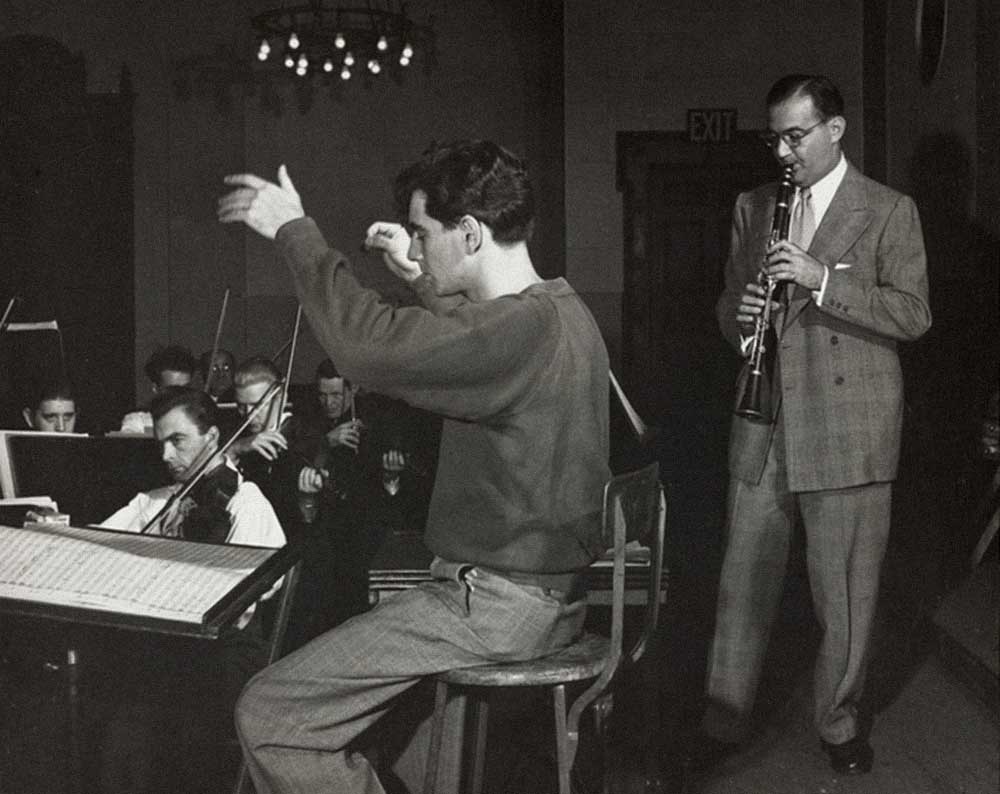Agustí Fancelli wrote in his review for El País “Leonard Bernstein or heterodoxy: he dances on the stage, shrugs, grabs the baton with both hands as if it were a baseball bat, then turns it into a delicate violin bow or a severe cello bow, smiles, grimaces, stomps around. The instrumentalists follow him, magnetized, they respond at each gesture with the expected sensitiveness, like lovers holding hands in the dark “. We do not know record of the event, but the Schumann’s First Symphony, “Spring” probably sounded similar to the fantastic version conducting the same orchestra, only a few months before, at the Musikverein in Vienna:
Bernstein’s passion, that magnetism -which animates the musicians of the orchestra, moved by the same current- is one of the features inherent to his artistic personality. It is evident both at the end of his career, in the eighties, as in the beginning. One of the first musical merits that was attributed to him was to get the eminent New York Philharmonic Orchestra, during its low hours during the fifties, to take off again, prioritizing the spectacular dimension of the more complex symphonic compositions, from Beethoven to Mahler, without overlooking Schumann and Brahms. But even more extraordinary –i. e., out of the ordinary- was his pedagogical work, deployed simultaneously and complementary to his activity as an orchestra director and composer.
Bernstein made numerous efforts to bring music closer to the public -not only to the one musically formed- implying thus that music always belongs to everyone. In the process, he diluted the borders of the tacit hierarchy that separated high, intellectual music, from other kind of popular or “folk” music; that is, the one made by and for “people”. His love for jazz, declared in words, is confirmed in the incorporation of themes and rhythms of traditional music into his own works. Something that some of the most avant-garde composers had already done, such as Bartók or Stravinsky.
“We do not always realize how important teachers are. Teaching is perhaps the essence of my function as conductor”
Exciting, but a little thoughtful can be his lessons at Harvard on the unutterable dimension of music, entitled The Unanswered Question, in dialogue with the flourishing linguistics of the time and Chomsky’s studies; more accessible -and no less exciting- are his appearances on TV. Even today they continue to awaken admiration due to Leonard Bernstein’s wonderful gift as communicator. Certainly, to achieve understanding musical concepts through images, metaphors or comparisons -all this translated with a sense of humour and prioritizing the human aspect of musical creation- is not an easy task. Some of its Telecasts, aimed at all kind of audiences, as well as the Young People’s Concerts (from 1958 to 1972), have been reproduced in the essential volume The Joy of Music, which starts with an affirmation absolutely eloquent, that we cannot but reproduce:
“Ever since I can remember I have talked about music, with friends, colleagues, teachers, students, and just plain, simple citizens. But in the last few years I have found myself talking about it publicly, thus joining the long line of well-meaning but generally doomed folk who have tried to explain the unique phenomenon of human reaction to organized sound. Ultimately one must simply accept the loving fact that people enjoy listening to organized sound (certain organized sounds, anyway); that this enjoyment can take the form of all kind of responses from animal excitement to spiritual exaltation; and that people who can organize sounds as to evoke the most exalted responses are commonly called geniuses”.
In another of his television interventions, Bernstein is sincere enough -he speaks from the heart, as usual, by the way- to point out how fundamental the task carried out by the teacher is: “We don’t always realize how important teachers are (…) teaching is probably the noblest profession in the world -the most unselfish, difficult and honourable profession. It is also the most unappreciated, underrated underpaid and underpraised profession (…) Teaching is perhaps the essence of my function as conductor”. Knowing how to put one self in the other’s shoes, knowing what he does not understand -so you can press the correct button, the one that makes him understand- is the Socratic art par excellence, that in the world of music provides highly tangible results, and of which we have testimonies.
REHARSAL AND PERFORMANCES OF THE RITE OF SPRING
One of the most fascinating audio-visual documents that are rather easy to find, despite its not so discreet edition -which gives it a more authentic tone, on the other hand- is the one that dates from 1987, in which a Bernstein already somewhat punished by the passage of time prepares a young orchestra for the interpretation of a work as important and complex as the Rite of Spring. The event takes place in the most suitable context, far from civilization (in Salzau, Schleswig-Holstein) and during a week of great intensity, that begins with mutual knowledge; a kind of recognition that, actually, is lacking any authoritarian formality. Unlike other teachers, Bernstein’s search for interpretive beauty also required emotional closeness, that was promoted through a contact that could become physical. In the Vienna Philharmonic they still remember his unexpected and effusive hugs, although in the case of the youngsters the closeness seems strictly musical.
“Who’s the unlucky man? You -says Bernstein, pointing at him with the baton-, all right. Coraggio! We all love you. So, that’s the first thing”
After having tested the sonority of the ensemble with a few scales, steered by him with different intensity, and having congratulated the musicians – “Oh, you’re wonderful!” – in order to win them for the common cause -that is, the commitment to interpretive excellence- Bernstein introduces them to the hard core of the piece musical they have to play: “Now… The Rite of Spring by Stravinski is all about… uhm… sex. And reproduction. And the smells from out there. Very good. Because it all means the same thing, and that is growth”. The Rite of Spring is, as we know, a major work for the history of music and culture of the twentieth century. It narrates how the threatening component of nature seeks to be mitigated through an archaic rite, by offering the sacrifice of a maiden, so that nature may be propitious and fruitful. A real challenge, to make boys and girls in bloom understand its abysmal reverse, to get them to obtain disconcertingly telluric -and yet well concerted- sounds from their instruments.
There are several memorable moments, from the very beginning, with the enigmatic and risky bassoon solo “that has to play in a very uncomfortable high register, and that sounds like anything but a bassoon”, explains Bernstein. For that reason, he looks at the wood instruments asking: “who’s the unlucky man?”. A coughing fit -forced to be identify, or induced by the tensions, or perhaps both- helps the maestro to locate him. “You -says Bernstein, pointing at him with the baton- all right”. Once identified that individual that accumulates an unusual degree of exposure, Bernstein seeks to promote an easy atmosphere with the words: “Coraggio! We all love you so, that’s the first thing” “Coraggio! We all love you. So, this is the most important thing”. Another remarkable moment, in which he seeks a reaction from his pupils, is that in which he recalls that they are already too educated – “trop bien eduqués“, he states in French, to make the message even clearer- and, therefore, they need to unleash themselves: leave behind for a moment the “right way to proceed” so to apprehend the non-conceptual language -not properly musical – that Stravinsky’s composition transmits and that Bernstein reproduces unashamed, with guttural sounds and very graphically, by comparing the work with a sort of “prehistoric jazz”.
No matter how insistently Bernstein tells the musicians to rise in order to receive the applause, they disobey. They reiterate that it is the maestro who is to be granted by the notable ovation.
 Adequate or not -that “primitive” expression – we know, in any case, that Igor Stravinsky himself had appreciated and validated live the approach of the first Bernstein. In flagrant contrast with the image of his last period, offered to the young orchestra with which he rehearsed in Salzau -looking like a Socrates from the Platonic Symposium– we can also have access to those early years’ recordings in front of the New York Philharmonic. They show a boy of impeccable appearance and nevertheless full of enthusiasm; an enthusiasm effusively dispensed throughout his career -as we said- to achieve the degree of commitment on the part of the musicians that requires interpretive excellence.
Adequate or not -that “primitive” expression – we know, in any case, that Igor Stravinsky himself had appreciated and validated live the approach of the first Bernstein. In flagrant contrast with the image of his last period, offered to the young orchestra with which he rehearsed in Salzau -looking like a Socrates from the Platonic Symposium– we can also have access to those early years’ recordings in front of the New York Philharmonic. They show a boy of impeccable appearance and nevertheless full of enthusiasm; an enthusiasm effusively dispensed throughout his career -as we said- to achieve the degree of commitment on the part of the musicians that requires interpretive excellence.
Between both eras, a video in which he interprets precisely The Rite of Spring with the London Symphony Orchestra shows the affection that the musicians could feel towards Bernstein, a conductor who even cared about the working conditions, interceding eventually on their behalf (it happened, for example, when he was conductor of the New York Philharmonic). At the end of that performance of Stravinsky’s masterpiece, no matter how insistently Bernstein tells the musicians to rise in order to receive the applause, they disobey, following the instructions of the concertino. They reiterate that it is the maestro who is to be granted by the notable ovation.



















